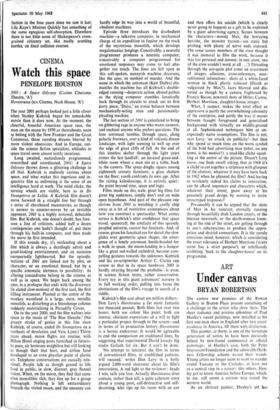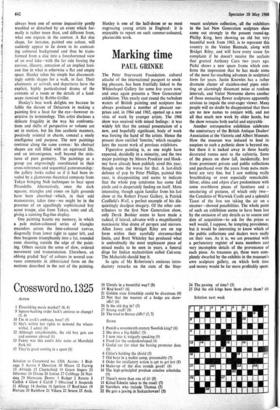Under canvas
ART BRYAN ROBERTSON
The austere new premises of the Rowan Gallery in Bruton Place present something of a challenge to the artists who show there. The sheer radiance and pristine splendour of Paul Huxley's recent paintings, now installed as his first one-man show in England after two years' residence in America, fill them with distinction.
This painter, at thirty, is one of the fortunate generation of artists to have been decisively helped by new-found commercial or official patronage : in Huxley's case, both the Peter Stuyvesant Foundation and the admirable Hark- ness Fellowship scheme waved their wands. Young artists no longer seem to want to wander round Tuscany or the Cyclades, at least not as a central step in a career: like others, Hux- ley got to know America before Europe, which, to me, still seems a curious way round the western world.
As an abstract painter, Huxley's art has always been one of serene impassivity gently troubled or disturbed by an event which for- mally is rather more than, and different from, what one expects in the context. A flat disc shape, for instance, painted one colour, will suddenly appear to lie down in its contrast- ing coloured background and thus be trans- formed from a disc into a foreshortened view of an oval lake—with the far side forcing the curious, illusory, sensation of an implied hori- zon line in what is otherwise a flat and empty space. Huxley takes his simple but disconcert- ingly subtle shapes for a walk, in fact. Their abutments or arrivals and departures have the explicit, highly particularised drama of the contents of a room or the details of a land- scape itemised by Robbe-Grillet.
Huxley's best work delights me because he fulfils the dictum of Delacroix in making a painting first a feast for the eye—however re- strictive its terminology. This artist discloses a delicate frugality in the way his confronta- tions and shifts of perspective or volume are set in motion, but his fine aesthetic manners, positively oriental in charm, conceal a steely intelligence and purpose. The new paintings continue along the same avenue: his abstract shapes are still filled with an equivocal life, and an intransigence, well beyond the stric- tures of pure geometry. The paintings as a group are engrossingly coordinated in their cross-references and sequential gamesmanship: the gallery looks rather as if it had been in- vaded by a glamorous theatrical company from Tokyo bringing Nob techniques to bear upon Pirandello. Alternatively, once the dark squares, triangles and cones on light grounds have been absorbed—which, in their odd manoeuvres, takes time—we might be in the presence of an appallingly sophisticated boy scout troupe, also from Tokyo, tents and all, giving a cunning flag-line display.
One painting haunts my memory, in which a pale melon-coloured series of triangles meanders across the lime-coloured canvas, diagonally from lower right to upper left, and then burgeons triumphantly into a fat, rounded cone shooting outside the edge of the paint- ing. Others sustain the sense of slow, ordered movement and transmutation. Elsewhere, an oblong graded 'key' of colours in several can- vases comments in abbreviated form on the motions described in the rest of the painting. Huxley is one of the half-dozen or so most engrossing young artists in England: it is enjoyable to report on such summer-Coloured, pleasurable work.







































 Previous page
Previous page